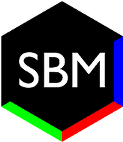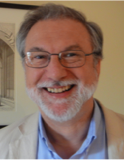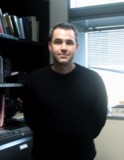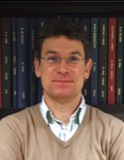ACADEMIC SUPERVISORS
Our teaching programme, laboratory rotations and research projects are supervised by internationally leading academics with interests that span the entire spectrum of organic chemistry. Our unique industrial-academic programme also offers opportunities for projects co-supervised by our industrial partners.
Expand the boxes for more information on specific research interests.
The Anderson group is interested in all aspects of synthetic organic chemistry, with a particular focus on the total synthesis of biologically active molecules, and the development of new reactions including transition metal-catalyzed transformations and cascade processes. We are interested in catalytic asymmetric reactions as a means to generate molecular complexity with a precise control over structure and stereochemistry, and also the theoretical modelling of these transformations. Our work also extends to biomolecules, such as chemically-modified DNA.
Selected Publications:
A robust and modular synthesis of ynamides. Steven J. Mansfield, Craig D. Campbell, Michael W. Jones, and Edward A. Anderson, Chem. Comm. 2014, 51, 3316.
Synthesis of Cyclic Alkenylsiloxanes by Semihydrogenation: A Stereospecific Route to (Z)-Alkenyl Polyenes. Bryony L. Elbert, Diane S. W. Lim, Haraldur G. Gudmundsson, Jack A. O'Hanlon and Edward A. Anderson, Chem. Eur. J. 2014, 20, 8594.
Ligand Bite Angle-Dependent Palladium-Catalyzed Cyclization of Propargylic Carbonates to 2-Alkynyl Azacycles or Cyclic Dienamides. D. S. B. Daniels, A. S. Jones, A. L. Thompson, R. S. Paton and E. A. Anderson, Angew. Chem. Int. Ed.2014, 53, 1915.
Palladium- and Ruthenium-Catalyzed Cycloisomerization of Enynamides and Enynhydrazides: A Rapid Approach to Diverse Azacyclic Frameworks. P. R. Walker, C. D. Campbell, A. Suleman, G. Carr and E. A. Anderson, Angew. Chem. Int. Ed. 2013, 52, 9139.
Synthesis of Cyclic Alkenylsiloxanes by Semihydrogenation: A Stereospecific Route to (Z)-Alkenyl Polyenes. Bryony L. Elbert, Diane S. W. Lim, Haraldur G. Gudmundsson, Jack A. O'Hanlon and Edward A. Anderson, Chem. Eur. J. 2014, 20, 8594.
Ligand Bite Angle-Dependent Palladium-Catalyzed Cyclization of Propargylic Carbonates to 2-Alkynyl Azacycles or Cyclic Dienamides. D. S. B. Daniels, A. S. Jones, A. L. Thompson, R. S. Paton and E. A. Anderson, Angew. Chem. Int. Ed.2014, 53, 1915.
Palladium- and Ruthenium-Catalyzed Cycloisomerization of Enynamides and Enynhydrazides: A Rapid Approach to Diverse Azacyclic Frameworks. P. R. Walker, C. D. Campbell, A. Suleman, G. Carr and E. A. Anderson, Angew. Chem. Int. Ed. 2013, 52, 9139.
Click for Selected Publications
Our Group does research in the areas of molecular materials synthesis, supramolecular chemistry, molecular recognition, polymers and dyes. Many of our projects are centred around the synthesis and subsequent physical investigation of porphyrins, rotaxanes and conjugated polymers. All work is directed towards the design and creation of new molecular materials with useful optical, electronic or biomedical properties. We believe that a better understanding of the relationship between molecular structure, molecular function and macroscopic properties will give us the ability to build functional materials on the molecular scale.
We investigate both the fundamental properties of protein channels and pores and their applications in biotechnology. With respect to the CDT, we use pores as nanoreactors to study covalent chemistry at the single-molecule level. Recently, this approach has been used to investigate complex reaction networks and the movement of molecular walkers.
Selected Publications:
A primary hydrogen-deuterium isotope effect observed at the single molecule level. Lu, S., Li, W.-W., Rotem, D., Mikhailova, E. and Bayley, H. A Nature Chemistry 2, 921-928 (2010). DOI: 10.1038/nchem.821
S-Nitrosothiol chemistry at the single-molecule level. Choi, L.-S. and Bayley, H. Angew. Chem. Int. Ed. 51, 7972-7976 (2012). DOI: 10.1002/anie.201202365
Single-molecule analysis of chirality in a multicomponent reaction network. Steffensen, M.B., Rotem, D. and Bayley, H. Nature Chemistry 6, 603-607 (2014). doi: 10.1038/nchem.1949
Continuous observation of the stochastic motion of an individual small-molecule walker. Pulcu, G.S., Mikhailova, E., Choi, L.-S. and Bayley, H. Nature Nanotechnology 10, 76-83 (2015). DOI: 10.1038/NNANO.2014.264
S-Nitrosothiol chemistry at the single-molecule level. Choi, L.-S. and Bayley, H. Angew. Chem. Int. Ed. 51, 7972-7976 (2012). DOI: 10.1002/anie.201202365
Single-molecule analysis of chirality in a multicomponent reaction network. Steffensen, M.B., Rotem, D. and Bayley, H. Nature Chemistry 6, 603-607 (2014). doi: 10.1038/nchem.1949
Continuous observation of the stochastic motion of an individual small-molecule walker. Pulcu, G.S., Mikhailova, E., Choi, L.-S. and Bayley, H. Nature Nanotechnology 10, 76-83 (2015). DOI: 10.1038/NNANO.2014.264
Click for Selected Publications
My general field of research is host-guest supramolecular chemistry, which covers a broad area of interests. With a view to increasing the understanding of molecular recognition processes in biological systems and producing new molecular sensors, switches and devices, my research is focused on the synthesis of novel macrocyclic and interlocked host molecules designed to complex and sense cationic, anionic or neutral inorganic or organic guest species via electrochemical and optical methods. Selective binding of a particular guest species is of paramount importance for commercial applications such as potential prototypes of new molecular sensory devices, molecular switches and extraction agents for cleansing the environment of toxic materials.
Selected Publications:
Halogen bonding in water results in enhanced anion recognition in acyclic and rotaxane hosts. M. J. Langton, S. W. Robinson, I. Marques, V. Felix and P. D. Beer. Nat.Chem., 2014, 6, 1039-1043. (Cover picture December 2014, featured in Nature Chemistry News and Views: Nat. Chem. 2014, 6, 1029-1031)
Iodide-induced shuttling of a halogen- and hydrogen-bonding two-station rotaxane. A. Caballero, L. Swan, F. Zapata and P. D. Beer. Angew. Chem. Int. Ed., 2014, 53, 11854-11858.
An all-halogen bonding rotaxane for selective sensing of halides in aqueous media. B. R. Mullaney, A. L. Thompson and P. D. Beer. Angew. Chem. Int. Ed., 2014, 53, 11458-11462 (Selected to be featured on inside cover of journal issue.)
Expanding the scope of the anion templated synthesis of interlocked structures. G. T. Spence and P. D. Beer. Acc. Chem. Res.; 2013, 46, 571-586.
Iodide-induced shuttling of a halogen- and hydrogen-bonding two-station rotaxane. A. Caballero, L. Swan, F. Zapata and P. D. Beer. Angew. Chem. Int. Ed., 2014, 53, 11854-11858.
An all-halogen bonding rotaxane for selective sensing of halides in aqueous media. B. R. Mullaney, A. L. Thompson and P. D. Beer. Angew. Chem. Int. Ed., 2014, 53, 11458-11462 (Selected to be featured on inside cover of journal issue.)
Expanding the scope of the anion templated synthesis of interlocked structures. G. T. Spence and P. D. Beer. Acc. Chem. Res.; 2013, 46, 571-586.
Click for Selected Publications
Our research is focussed on structural and dynamical biology: determining the forms, movements, and interactions of protein assemblies and how they underpin function. We perform experiments primarily using cutting-edge MS techniques, but also combine these measurements with crystallographic, electron microscopic and nuclear magnetic resonance, as well as a variety of sophisticated computational tools. Currently our work is focused on investigating protein misfolding and deposition, which can lead to diseases such as Alzheimer’s, and in particular the molecular mechanisms of how they are kept in check by the natural defences of the cell.
Selected Publications:
A structured core domain of aB-crystallin can prevent amyloid fibrillation and associated toxicity. Hochberg, G.K.A., Ecroyd, H., Liu, C., Cox, D., Cascio, D., Sawaya, M.R., Collier, M.P., Stroud, J., Carver, J.A., Baldwin, A.J., Robinson, C.V., Eisenberg, D., Benesch, J.L.P., Laganowsky, A. Proceedings of the National Academy of Sciences USA, (2014), 111, E1562-70
Collision cross sections for structural proteomics. Marklund, E.G., Degiacomi, M.T., Robinson, C.V., Baldwin, A.J., Benesch, J.L.P. Structure, (2015), 23, 791-9
The polydispersity of aB-crystallin is rationalized by an inter-converting polyhedral architecture. Baldwin, A.J., Lioe, H., Hilton, G., Bagnéris, C., Baker, L.A., Rubinstein, J.L., Lay, L.E., Benesch, J.L.P Structure (2011), 19, 1855-63
Quaternary dynamics and plasticity underlie small heat shock protein chaperone function. Stengel, F., Baldwin, A.J., Painter, A.J., Jaya, N., Basha, E., Kay, L.E., Vierling, E., Robinson, C.V., Benesch, J.L.P. Proceedings of the National Academy of Sciences USA (2010) 107, 2007-12
Collision cross sections for structural proteomics. Marklund, E.G., Degiacomi, M.T., Robinson, C.V., Baldwin, A.J., Benesch, J.L.P. Structure, (2015), 23, 791-9
The polydispersity of aB-crystallin is rationalized by an inter-converting polyhedral architecture. Baldwin, A.J., Lioe, H., Hilton, G., Bagnéris, C., Baker, L.A., Rubinstein, J.L., Lay, L.E., Benesch, J.L.P Structure (2011), 19, 1855-63
Quaternary dynamics and plasticity underlie small heat shock protein chaperone function. Stengel, F., Baldwin, A.J., Painter, A.J., Jaya, N., Basha, E., Kay, L.E., Vierling, E., Robinson, C.V., Benesch, J.L.P. Proceedings of the National Academy of Sciences USA (2010) 107, 2007-12
Click for Selected Publications
The Brennan Group at the SGC is developing small molecule chemical probes for epigenetic targets in order to elucidate their role in disease. We are also developing new methods for fragment based drug discovery in collaboration with Diamond Light Source to find ortho- and allosteric hits for difficult to drug proteins.
Our chemical probes are developed into drug discovery projects at the Alzheimer’s Research UK Oxford Dementia Drug Discovery Institute. We are working on new treatments for Alzheimer’s Disease, Parkinson’s Disease, Vascular Dementia and Frontal Temporal Dementia in collaboration with scientists across the University.
Our chemical probes are developed into drug discovery projects at the Alzheimer’s Research UK Oxford Dementia Drug Discovery Institute. We are working on new treatments for Alzheimer’s Disease, Parkinson’s Disease, Vascular Dementia and Frontal Temporal Dementia in collaboration with scientists across the University.
Selected Publications:
Identification and development of 2,3-dihydropyrrolo[1,2- a ]quinazolin-5(1 H )-one inhibitors targeting bromodomains within the Switch/Sucrose Non-Fermenting complex. Sutherell, C. L.; Tallant, C.; Monteiro, O. P.; Yapp, C.; Fuchs, J. E.; Fedorov, O.; Siejka, P.; Müller, S.; Knapp, S.; Brenton, J. D.; Brennan, P. E.; Ley, S. V., J. Med. Chem., 2016, 5.
8-Substituted Pyrido[3,4-d]pyrimidin-4(3H)-one Derivatives As Potent, Cell Permeable, KDM4 (JMJD2) and KDM5 (JARID1) Histone Lysine Demethylase Inhibitors. J. Med. Chem., 2016, 59, 1388.
A poised fragment library enables rapid synthetic expansion yielding the first reported inhibitors of PHIP(2), an atypical bromodomain. Cox, O. B.; Krojer, T.; Collins, P.; Monteiro, O.; Talon, R.; Bradley, A.; Fedorov, O.; Amin, J.; Marsden, B. D.; Spencer, J.; von Delft, F.; Brennan, P. E., Chem. Sci., 2016
LP99: Discovery and Synthesis of the First Selective BRD7/9 Bromodomain Inhibitor. Clark, P. G. K.; Vieira, L. C. C.; Tallant, C.; Fedorov, O.; Singleton, D. C.; Rogers, C. M.; Monteiro, O. P.; Bennett, J. M.; Baronio, R.; Müller, S.; Daniels, D. L.; Méndez, J.; Knapp, S.; Brennan, P. E.; Dixon, D. J., Angew. Chemie Int. Ed., 2015, 54, 6217.
Design and synthesis of potent and selective inhibitors of BRD7 and BRD9 bromodomains. Hay, D. A.; Rogers, C. M.; Fedorov, O.; Tallant, C.; Martin, S.; Monteiro, O. P.; Muller, S.; Knapp, S.; Schofield, C. J.; Brennan, P. E., Medchemcomm, 2015, 6 , 1381.
8-Substituted Pyrido[3,4-d]pyrimidin-4(3H)-one Derivatives As Potent, Cell Permeable, KDM4 (JMJD2) and KDM5 (JARID1) Histone Lysine Demethylase Inhibitors. J. Med. Chem., 2016, 59, 1388.
A poised fragment library enables rapid synthetic expansion yielding the first reported inhibitors of PHIP(2), an atypical bromodomain. Cox, O. B.; Krojer, T.; Collins, P.; Monteiro, O.; Talon, R.; Bradley, A.; Fedorov, O.; Amin, J.; Marsden, B. D.; Spencer, J.; von Delft, F.; Brennan, P. E., Chem. Sci., 2016
LP99: Discovery and Synthesis of the First Selective BRD7/9 Bromodomain Inhibitor. Clark, P. G. K.; Vieira, L. C. C.; Tallant, C.; Fedorov, O.; Singleton, D. C.; Rogers, C. M.; Monteiro, O. P.; Bennett, J. M.; Baronio, R.; Müller, S.; Daniels, D. L.; Méndez, J.; Knapp, S.; Brennan, P. E.; Dixon, D. J., Angew. Chemie Int. Ed., 2015, 54, 6217.
Design and synthesis of potent and selective inhibitors of BRD7 and BRD9 bromodomains. Hay, D. A.; Rogers, C. M.; Fedorov, O.; Tallant, C.; Martin, S.; Monteiro, O. P.; Muller, S.; Knapp, S.; Schofield, C. J.; Brennan, P. E., Medchemcomm, 2015, 6 , 1381.
Click for Selected Publications
My research focuses on the chemical synthesis of modified nucleic acids (DNA and RNA) for use gene synthesis, in genetic analysis, forensic analysis and therapeutics. We have recently started working on oligonucleotide aptamers as potential anti-cancer agents, focusing on targeting and delivery to tumour cells.
Selected Publications:
Combined nucleobase and backbone modifications enhance DNA duplex stability and preserve biocompatibility. El-Sagheer, A.H. and Brown, T. Chemical Science (2014), 5, 253-259.
Transcription of Click-Linked DNA in Human Cells. Birts, C.N., Sanzone, A.P., El-Sagheer, A.H., Blaydes, J.P., Brown, T. and Tavassoli, A. Angew. Chem. Int. Edit. (2014), 53, 2362-2365.
Biocompatible artificial DNA linker that is read through by DNA polymerases and is functional in E. coli. El-Sagheer, A.H., Sanzone, A.P., Gao, R., Tavassoli, A. and Brown, T. Proc. Natl. Acad. Sci. U. S. A. (2011), 108, 11338–11343.
New strategy for the synthesis of chemically modified RNA constructs exemplified by hairpin and hammerhead ribozymes. El-Sagheer, A.H. and Brown, T. Proc. Natl. Acad. Sci. U. S. A. (2010), 107, 15329-15334.
Transcription of Click-Linked DNA in Human Cells. Birts, C.N., Sanzone, A.P., El-Sagheer, A.H., Blaydes, J.P., Brown, T. and Tavassoli, A. Angew. Chem. Int. Edit. (2014), 53, 2362-2365.
Biocompatible artificial DNA linker that is read through by DNA polymerases and is functional in E. coli. El-Sagheer, A.H., Sanzone, A.P., Gao, R., Tavassoli, A. and Brown, T. Proc. Natl. Acad. Sci. U. S. A. (2011), 108, 11338–11343.
New strategy for the synthesis of chemically modified RNA constructs exemplified by hairpin and hammerhead ribozymes. El-Sagheer, A.H. and Brown, T. Proc. Natl. Acad. Sci. U. S. A. (2010), 107, 15329-15334.
Click for Selected Publications
Our research interests are as follows: total synthesis of natural products, structure determination and methods development. We are interested in: the development of key reaction methodology, especially in the areas of oxidative radical cyclisations and transition metal catalysed processes; all aspects of the structure and conformational preferences of ring compounds; and the use of biosynthesis and computational methods as predictive tools for the structure determination of complex molecules. All of the above inform and guide our research on complex molecule total synthesis.
Selected Publications:
Diastereoselective Synthesis of Fused Lactone-Pyrrolidinones; Application to a Formal Synthesis of (−)-Salinosporamide. A A. W. J. Logan, S. J. Sprague, R. W. Foster, L. B. Marx, V. Garzya, M. S. Hallside, A. L. Thompson, J. W. Burton, Org. Lett. 2014, 16, 4078.
Structure Reassignment of Laurefurenynes A and B by Computation and Total Synthesis. D. J. Shepherd, P. A. Broadwith, B. S. Dyson, R. S. Paton, J. W. Burton, Chem. Eur. J., 2013, 19, 12644.
Total synthesis and structure confirmation of elatenyne: success of computational methods for NMR prediction with highly flexible diastereomers. B. S. Dyson, J. W. Burton, T. I. Sohn, B. Kim, H. Bae, D. Kim, J. Am. Chem. Soc., 2012, 134, 11781.
A Zinc(II) catalyst system for the Conia-ene reaction of alkynyl aminomalonates applicable to 5-endo-dig reactions. W. Hess and J. W Burton, Adv. Synth. Catal., 2011, 353, 2966.
Structure Reassignment of Laurefurenynes A and B by Computation and Total Synthesis. D. J. Shepherd, P. A. Broadwith, B. S. Dyson, R. S. Paton, J. W. Burton, Chem. Eur. J., 2013, 19, 12644.
Total synthesis and structure confirmation of elatenyne: success of computational methods for NMR prediction with highly flexible diastereomers. B. S. Dyson, J. W. Burton, T. I. Sohn, B. Kim, H. Bae, D. Kim, J. Am. Chem. Soc., 2012, 134, 11781.
A Zinc(II) catalyst system for the Conia-ene reaction of alkynyl aminomalonates applicable to 5-endo-dig reactions. W. Hess and J. W Burton, Adv. Synth. Catal., 2011, 353, 2966.
Click for Selected Publications
My research interests revolve around the application of solution-state NMR techniques to address questions of structure, function and dynamics of "small" molecules in organic chemistry and chemical biology. Many of the projects in which I become involved arise through collaborations with groups across the department and the university more widely.
Our research interests are at the interface of chemistry and biology and focus on the use of synthetic organic chemistry to enable the study of biological problems. Key areas of activity include the synthesis of inositol-based probes to study intracellular calcium signalling, the synthesis of inositol-based compounds to probe pleckstrin homology domains and the use of photolabile protecting groups to develop light-activated molecular tools. We have collaborative interests in bacterial potassium channels and the molecular mechanisms involved in Alzheimer’s disease. Our interests also encompass the synthesis of “drug-like” molecules and we have recently reported an improved synthesis of hydantoins.
Research within the Davies group is concerned with investigations into a wide variety of topics including the development of new synthetic methodology, catalysis, mechanistic investigations, total synthesis and projects in medicinal chemistry.
Selected Publications:
Stemistry: the control of stem cells in situ using chemistry. Davies, S. G.; Kennewell, P. D.; Russell, A. J.; Seden, P. T.; Westwood, R.; Wynne, G. M.
J. Med. Chem. 2015, DOI: 10.1021/jm500838d
Asymmetric syntheses of (–)-3-epi-fagomine, (2R,3S,4R)-dihydroxypipecolic acid and several polyhydroxylated homopipecolic acids. Csatayová, K.; Davies, S. G.; Fletcher, A. M.; Ford, J. G.; Klauber, D. J.; Roberts, P. M.; Thomson, J. E. J. Org. Chem. 2014, 79, 10932
Stereospecific cyclisation strategies for α,ε-dihydroxy-β-amino esters: asymmetric syntheses of imino and amino sugars Davies, S. G.; Foster, E. M.; Lee, J. A.; Roberts, P. M.; Thomson, J. E. J. Org. Chem. 2014, 79, 9686
(–)-(2S,3R,Z)-Nakinadine A: first asymmetric synthesis and absolute configuration assignment. Davies, S. G.; Fletcher, A. M.; Roberts, P. M.; Shah, R. S.; Thompson, A. L.; Thomson, J. E. Org. Lett. 2014, 16, 1354
J. Med. Chem. 2015, DOI: 10.1021/jm500838d
Asymmetric syntheses of (–)-3-epi-fagomine, (2R,3S,4R)-dihydroxypipecolic acid and several polyhydroxylated homopipecolic acids. Csatayová, K.; Davies, S. G.; Fletcher, A. M.; Ford, J. G.; Klauber, D. J.; Roberts, P. M.; Thomson, J. E. J. Org. Chem. 2014, 79, 10932
Stereospecific cyclisation strategies for α,ε-dihydroxy-β-amino esters: asymmetric syntheses of imino and amino sugars Davies, S. G.; Foster, E. M.; Lee, J. A.; Roberts, P. M.; Thomson, J. E. J. Org. Chem. 2014, 79, 9686
(–)-(2S,3R,Z)-Nakinadine A: first asymmetric synthesis and absolute configuration assignment. Davies, S. G.; Fletcher, A. M.; Roberts, P. M.; Shah, R. S.; Thompson, A. L.; Thomson, J. E. Org. Lett. 2014, 16, 1354
Click for Selected Publications
Our research centres on the chemical understanding and exploitation of biomolecular function, especially carbohydrates and proteins. Interests and methods encompass organic synthesis & methodology, target biomolecule synthesis, inhibitor/probe/substrate design, biocatalysis, enzyme & biomolecule mechanism, biosynthetic pathway determination, protein engineering, drug delivery, molecular biology, structural biology, cell biology, molecular imaging and in vivo biology.
Darren has broad research interests in the field of organic synthesis with projects spanning the discovery of new reactions and reactivity, the development of this into powerful synthetic methodology and its application to the total synthesis of natural products and molecules of biological significance. His group is renown for discovering smart and broadly useful solutions to intractable problems in chemical synthesis using bespoke multifunctional catalysts that simultaneously activate reagents and substrates and bring about their union with exquisite levels of stereocontrol.
Selected Publications:
Direct Catalytic Enantio- and Diastereoselective Mannich Reaction of Isocyanoacetates and Ketimines. I. Ortín, D. J. Dixon, Angew. Chem. Int. Ed. 2014, 53, 3462-3465.
Diastereodivergent organocatalytic asymmetric vinylogous Michael reactions. X. Li, M. Lu, Y. Dong, W. Wu, Q. Qian, J. Ye, D. J. Dixon, Nature Communications, 2014, 5, 4479.
Enantioselective Desymmetrization of Prochiral Cyclohexanones by Organocatalytic Intramolecular Michael Additions to α,β-Unsaturated Esters. A. D. Gammack Yamagata, S. Datta, K. E. Jackson, L. Stegbauer, R. S. Paton, D. J. Dixon, Angew. Chem. Int. Ed. 2015, 54, 4899-4903.
Direct catalytic enantio- and diastereoselective ketone aldol reactions of isocyanoacetates. R. De La Campa, I. Ortín, D. J. Dixon, Angew. Chem. Int. Ed. 2015, 54, 4895-4898
Diastereodivergent organocatalytic asymmetric vinylogous Michael reactions. X. Li, M. Lu, Y. Dong, W. Wu, Q. Qian, J. Ye, D. J. Dixon, Nature Communications, 2014, 5, 4479.
Enantioselective Desymmetrization of Prochiral Cyclohexanones by Organocatalytic Intramolecular Michael Additions to α,β-Unsaturated Esters. A. D. Gammack Yamagata, S. Datta, K. E. Jackson, L. Stegbauer, R. S. Paton, D. J. Dixon, Angew. Chem. Int. Ed. 2015, 54, 4899-4903.
Direct catalytic enantio- and diastereoselective ketone aldol reactions of isocyanoacetates. R. De La Campa, I. Ortín, D. J. Dixon, Angew. Chem. Int. Ed. 2015, 54, 4895-4898
Click for Selected Publications
The TJD group is interested in the development of new catalytic methods, and then the application of these new reactions to challenging total synthesis projects. Recent work has focussed on metathesis, palladium cross coupling and hydrogen borrowing chemistry, and each project that we explore is then tested in the synthesis of a biologically active target.
Selected Publications:
Hydrogen borrowing and interrupted hydrogen borrowing reactions of ketones and methanol, catalysed by iridium. Di Shen, Darren L. Poole, Camilla C. Shotton, Anne F. Kornahrens, Mark P. Healy and Timothy J. Donohoe, Angewandte Chemie Int. Ed. (2015), 54, 1642-1645.
Short and efficient syntheses of protoberberine alkaloids using palladium catalyzed enolate arylation. Alice E. Gatland, Ben S. Pilgrim, Panayiotis A. Procopiou and Timothy J. Donohoe, Angewandte Chemie Int. Ed., (2014) 53, 14555-14558.
Rhodium-Catalyzed Ketone Methylation Using Methanol Under Mild Conditions: Formation of Alpha-Branched Products. Louis K. M. Chan, Darren L. Poole, Di Shen, Mark P. Healy and Timothy J. Donohoe, Angewandte Chemie Int. Ed. (2014), 53, 761-765.
Total Synthesis of (±)-Streptonigrin: De-novo Construction of a Pentasubstituted Pyridine using Ring Closing Metathesis, Timothy J. Donohoe, Christopher Jones and Luiz Claudio Barbosa, J. Am. Chem. Soc.(2011), 133, 16418.
Short and efficient syntheses of protoberberine alkaloids using palladium catalyzed enolate arylation. Alice E. Gatland, Ben S. Pilgrim, Panayiotis A. Procopiou and Timothy J. Donohoe, Angewandte Chemie Int. Ed., (2014) 53, 14555-14558.
Rhodium-Catalyzed Ketone Methylation Using Methanol Under Mild Conditions: Formation of Alpha-Branched Products. Louis K. M. Chan, Darren L. Poole, Di Shen, Mark P. Healy and Timothy J. Donohoe, Angewandte Chemie Int. Ed. (2014), 53, 761-765.
Total Synthesis of (±)-Streptonigrin: De-novo Construction of a Pentasubstituted Pyridine using Ring Closing Metathesis, Timothy J. Donohoe, Christopher Jones and Luiz Claudio Barbosa, J. Am. Chem. Soc.(2011), 133, 16418.
Click for Selected Publications
Our multi-disciplinary research involves the development of metal-based systems and drug delivery carriers that respond to external stimuli (light, ultrasound) for applications in medical imaging and therapy. Currently we are developing novel redox activatable platinum (IV) anti-cancer prodrugs and investigating their liposomal encapsulation. We are incorporating these into drug delivery vehicles and releasing the prodrugs using ultrasound, in collaboration with researchers at the Institute of Biomedical Engineering (Oxford). We also collaborate within the Chemistry Department to investigate biological targeting and fluorescent imaging of these systems.
Selected Publications:
De novo generation of singlet oxygen and ammine ligands by photoactivation of a platinum anticancer complex, Y. Zhao, N. J. Farrer, H. Li, J. S. Butler, R. J. McQuitty, A. Habtemariam, F. Wang, P. J. Sadler, Angew. Chem. Int. Ed., 2013, 52, 13633.
Tryptophan Switch for a photoactivated platinum anticancer complex, J. S. Butler, J. A. Woods, N. J. Farrer, M. E. Newton, P. J. Sadler, J. Am. Chem. Soc., 2012, 134, 16508.
Probing Platinum Azides with 15N and 14N NMR Spectroscopy, N. J. Farrer (corresponding author), P. Gierth, P. J. Sadler, Chem. Eur J., 2011, 17, 12059.
A Potent Trans Diimine Platinum Anticancer Complex Photoactivated by Visible Light, N. J. Farrer, J. A. Woods, L. Salassa, Y. Zhao, K. S. Robinson, G. Clarkson, F. S. Mackay, P. J. Sadler, Angew. Chem. Int. Ed., 2010, 49, 8905.
Tryptophan Switch for a photoactivated platinum anticancer complex, J. S. Butler, J. A. Woods, N. J. Farrer, M. E. Newton, P. J. Sadler, J. Am. Chem. Soc., 2012, 134, 16508.
Probing Platinum Azides with 15N and 14N NMR Spectroscopy, N. J. Farrer (corresponding author), P. Gierth, P. J. Sadler, Chem. Eur J., 2011, 17, 12059.
A Potent Trans Diimine Platinum Anticancer Complex Photoactivated by Visible Light, N. J. Farrer, J. A. Woods, L. Salassa, Y. Zhao, K. S. Robinson, G. Clarkson, F. S. Mackay, P. J. Sadler, Angew. Chem. Int. Ed., 2010, 49, 8905.
Click for Selected Publications
Stephen Faulkner’s group is focused on the synthesis of macrocyclic and multimacrocyclic systems that can be used in the diagnosis of disease by MRI and optical methods. Their current objective is to develop molecules that respond radiometrically to key biomarkers for hypoxia and ischaemia
Selected Publications:
M. Tropiano, A.M. Kenwright and S. Faulkner. Chem. Eur. J. 2015, 21, 5679
DOI: 10.1002/chem.201500188
T. Just Sørensen, A.M. Kenwright and S. Faulkner, Chem. Sci. 2015, 6, 2054-2059 DOI: 10.1039/c4sc03827d
M. Tropiano and S. Faulkner, Chem. Commun. 2014, 50, 4696-4698.
DOI: 10.1039/C4CC01095G
M. Tropiano, O.A. Blackburn, J.A. Tilney, L.R. Hill, M.P. Placidi, R.J. Aarons, D. Sykes, M.W. Jones, A.M. Kenwright, J.S. Snaith, T. Just Sørensen and Stephen Faulkner, Chem. Eur. J., 2013, 19, 16566
DOI: 10.1002/chem.201303183
DOI: 10.1002/chem.201500188
T. Just Sørensen, A.M. Kenwright and S. Faulkner, Chem. Sci. 2015, 6, 2054-2059 DOI: 10.1039/c4sc03827d
M. Tropiano and S. Faulkner, Chem. Commun. 2014, 50, 4696-4698.
DOI: 10.1039/C4CC01095G
M. Tropiano, O.A. Blackburn, J.A. Tilney, L.R. Hill, M.P. Placidi, R.J. Aarons, D. Sykes, M.W. Jones, A.M. Kenwright, J.S. Snaith, T. Just Sørensen and Stephen Faulkner, Chem. Eur. J., 2013, 19, 16566
DOI: 10.1002/chem.201303183
Click for Selected Publications
We are a synthetic organic chemistry group – we develop new catalytic asymmetric methods for synthesis. We also build model systems to study and understand important processes in chemistry and biology. Our current efforts can be roughly divided into the following areas: design and understanding of new catalytic asymmetric C-C bond forming reactions using readily available starting materials; autocatalytic chemical reactions that may be relevant to the origins of life on Earth; and learning how to control and use photochemical isomerization processes to develop systems capable of work.
Selected Publications:
Non-stabilized nucleophiles in Cu-catalysed dynamic kinetic asymmetric allylic alkylation. H. You, E. Rideau, M. Sidera, S. P. Fletcher. Nature 2015, 517, 351–355.
Physical autocatalysis driven by a bond-forming thiol-ene reaction. A. J. Bissette, B. Odell and S. P. Fletcher. Nature Comm. 2014, 5, 4607.
Conversion of light into macroscopic helical motion. S. Iamsaard, S. J. Aβhoff, B. Matt, T. Kudernac, J. J. L. M. Cornelissen, S. P. Fletcher and N. Katsonis. Nature Chemistry. 2014, 6, 229-235.
Synthetic control of retinal photochemistry and photophysics in solution. G. Bassolino, T. Sovdat, M. Liebel, C. Schnedermann, B. Odell, T. D. W. Claridge, P. Kukura and S. P. Fletcher. J. Am. Chem. Soc. 2014, 136, 2650-2658.
Physical autocatalysis driven by a bond-forming thiol-ene reaction. A. J. Bissette, B. Odell and S. P. Fletcher. Nature Comm. 2014, 5, 4607.
Conversion of light into macroscopic helical motion. S. Iamsaard, S. J. Aβhoff, B. Matt, T. Kudernac, J. J. L. M. Cornelissen, S. P. Fletcher and N. Katsonis. Nature Chemistry. 2014, 6, 229-235.
Synthetic control of retinal photochemistry and photophysics in solution. G. Bassolino, T. Sovdat, M. Liebel, C. Schnedermann, B. Odell, T. D. W. Claridge, P. Kukura and S. P. Fletcher. J. Am. Chem. Soc. 2014, 136, 2650-2658.
Click for Selected Publications
Our research program can be divided into two broad categories: (1) Chemical Advances for the synthesis of structurally and biologically compelling small fluorinated molecules for applications in medicinal chemistry, & (2) Radiochemical Advances for the production of [18F]labelled biomarkers for applications in Positron Emission Tomography. Such advances are crucial to interrogate molecular interactions in organisms and to develop new synthetic [18F]labelled (bio)molecules tools to diagnose, monitor and treat diseases.
Selected Publications:
A General Copper-Mediated Nucleophilic 18F Fluorination of Arenes. M. Tredwell, S. M. Preshlock, N. J. Taylor, S. Gruber, M. Huiban, J. Passchier, J. Mercier, C. Génicot, V. Gouverneur. Angew. Chem. Int. Ed. 2014, 53 (30), 7751-7755
cis-Specific Hydrofluorination of Alkenylarenes under Palladium Catalysis by an Ionic Pathway. E. Emer, L. Pfeifer, J. M. Brown, V. Gouverneur. Angew. Chem. Int. Ed. 2014, 53 (16), 4181–4185
A Broadly Applicable [18F]Trifluoromethylation of Aryl and Heteroaryl Iodides for PET Imaging. M. Huiban, M. Tredwell, S. Mizuta, Z. Wan, X. Zhang, T. L. Collier, V. Gouverneur, J. Passchier. Nature Chemistry 2013, 5, 941-944
Catalytic Hydrotrifluoromethylation of Unactivated Alkenes. S. Mizuta, S. Verhoog, K. M. Engle, T. Khotavivattana M. O’Duill, K. Wheelhouse, G. Rassias, M. Medebielle, V. Gouverneur. J. Am. Chem. Soc. 2013, 135 (7), 2505-250
cis-Specific Hydrofluorination of Alkenylarenes under Palladium Catalysis by an Ionic Pathway. E. Emer, L. Pfeifer, J. M. Brown, V. Gouverneur. Angew. Chem. Int. Ed. 2014, 53 (16), 4181–4185
A Broadly Applicable [18F]Trifluoromethylation of Aryl and Heteroaryl Iodides for PET Imaging. M. Huiban, M. Tredwell, S. Mizuta, Z. Wan, X. Zhang, T. L. Collier, V. Gouverneur, J. Passchier. Nature Chemistry 2013, 5, 941-944
Catalytic Hydrotrifluoromethylation of Unactivated Alkenes. S. Mizuta, S. Verhoog, K. M. Engle, T. Khotavivattana M. O’Duill, K. Wheelhouse, G. Rassias, M. Medebielle, V. Gouverneur. J. Am. Chem. Soc. 2013, 135 (7), 2505-250
Click for Selected Publications
Our research programme revolves around the theme of synthesis and encompasses broadly based studies directed towards the design and development of new methods, reagents and strategies for the synthesis of biologically active molecules. Specific research areas of current interest include the following: direct functionalisation of small heterocycles (especially azetidines and azetines); direct generation of enantioenriched α-alkyl-substituted aldehydes; catalytic enantioselective tandem ylide formation - pericyclic processes; and cascade chemistry for azacycle synthesis.
Selected Publications:
Amine Protection/α-Activation with the tert-Butoxythiocarbonyl Group: Application to Azetidine Lithiation-Electrophilic Substitution. D. M. Hodgson, C. L. Mortimer and J. M. McKenna, Org. Lett., 2015, 17, 330.
Intramolecular Oxonium Ylide Formation-[2,3] Sigmatropic Rearrangement of Diazocarbonyl-Substituted Cyclic Unsaturated Acetals: A Formal Synthesis of Hyperolactone C. D. M. Hodgson, S. Man, K. J. Powell, Z. Perko, M. Zeng, E. Moreno-Clavijo, A. L. Thompson and M. D. Moore. J. Org. Chem., 2014, 79, 9728.
C-Alkylation of Chiral Tropane- and Homotropane-Derived Enamines. D. M. Hodgson, A. Charlton, R. S. Paton and A. L. Thompson, J. Org. Chem. 2013, 78, 1508.
Catalytic Asymmetric Synthesis of (+)-Anthecotulide Using Enyne and Meyer–Schuster Rearrangements. D. M. Hodgson, E. P. A. Talbot, and B. P. Clark, Org. Lett. 2011, 13, 5751.
Intramolecular Oxonium Ylide Formation-[2,3] Sigmatropic Rearrangement of Diazocarbonyl-Substituted Cyclic Unsaturated Acetals: A Formal Synthesis of Hyperolactone C. D. M. Hodgson, S. Man, K. J. Powell, Z. Perko, M. Zeng, E. Moreno-Clavijo, A. L. Thompson and M. D. Moore. J. Org. Chem., 2014, 79, 9728.
C-Alkylation of Chiral Tropane- and Homotropane-Derived Enamines. D. M. Hodgson, A. Charlton, R. S. Paton and A. L. Thompson, J. Org. Chem. 2013, 78, 1508.
Catalytic Asymmetric Synthesis of (+)-Anthecotulide Using Enyne and Meyer–Schuster Rearrangements. D. M. Hodgson, E. P. A. Talbot, and B. P. Clark, Org. Lett. 2011, 13, 5751.
Click for Selected Publications
The Huber laboratory is focused on the identification and design of small molecule tools, so-called “chemical probes”, that enable the functional exploration of proteins implicated with human disease. Key to these efforts is the use of chemical biology to study the interaction of small molecules and drugs with cellular systems.
To this end, the group combines a variety of different approaches such as medicinal chemistry, small molecule screening, biochemical assays, protein X-ray crystallography, chemical and protein-protein interaction proteomics, RNAi as well as genome-editing alongside classical molecular and cellular biology techniques.
To this end, the group combines a variety of different approaches such as medicinal chemistry, small molecule screening, biochemical assays, protein X-ray crystallography, chemical and protein-protein interaction proteomics, RNAi as well as genome-editing alongside classical molecular and cellular biology techniques.
Selected Publications:
Proteome-wide drug and metabolite interaction mapping by thermal-stability profiling. Huber, K. V. M.; Olek, K. M.; Müller, A. C.; Tan, C. S. H.; Bennett, K. L.; Colinge, J. and Superti-Furga, G., Nat Meth 2015, 12 (11), 1055-1057.
The promise and peril of chemical probes. Arrowsmith, C. H. et al., Nat. Chem. Biol. 2015, 11 (8), 536-541.
A cellular screen identifies ponatinib and pazopanib as inhibitors of necroptosis. Fauster, A.; Rebsamen, M.; Huber, K. V. M.; Bigenzahn, J. W.; Stukalov, A.; Lardeau, C. H.; Scorzoni, S.; Bruckner, M.; Gridling, M.; Parapatics, K.; Colinge, J.; Bennett, K. L.; Kubicek, S.; Krautwald, S.; Linkermann, A.; Superti-Furga, G., Cell Death Dis 2015, 6, e1767
7,8-Dichloro-1-oxo-β-carbolines as a Versatile Scaffold for the Development of Potent and Selective Kinase Inhibitors with Unusual Binding Modes. Huber, K.; Brault, L.; Fedorov, O.; Gasser, C.; Filippakopoulos, P.; Bullock, A. N.; Fabbro, D.; Trappe, J.; Schwaller, J.; Knapp, S.; Bracher, F., J. Med. Chem. 2012, 55 (1), 403-413.
Specific CLK Inhibitors from a Novel Chemotype for Regulation of Alternative Splicing. Fedorov, O.; Huber, K.; Eisenreich, A.; Filippakopoulos, P.; King, O.; Bullock, A. N.; Szklarczyk, D.; Jensen, L. J.; Fabbro, D.; Trappe, J.; Rauch, U.; Bracher, F.; Knapp, S., Chem Biol 2011, 18 (1), 67-76.
The promise and peril of chemical probes. Arrowsmith, C. H. et al., Nat. Chem. Biol. 2015, 11 (8), 536-541.
A cellular screen identifies ponatinib and pazopanib as inhibitors of necroptosis. Fauster, A.; Rebsamen, M.; Huber, K. V. M.; Bigenzahn, J. W.; Stukalov, A.; Lardeau, C. H.; Scorzoni, S.; Bruckner, M.; Gridling, M.; Parapatics, K.; Colinge, J.; Bennett, K. L.; Kubicek, S.; Krautwald, S.; Linkermann, A.; Superti-Furga, G., Cell Death Dis 2015, 6, e1767
7,8-Dichloro-1-oxo-β-carbolines as a Versatile Scaffold for the Development of Potent and Selective Kinase Inhibitors with Unusual Binding Modes. Huber, K.; Brault, L.; Fedorov, O.; Gasser, C.; Filippakopoulos, P.; Bullock, A. N.; Fabbro, D.; Trappe, J.; Schwaller, J.; Knapp, S.; Bracher, F., J. Med. Chem. 2012, 55 (1), 403-413.
Specific CLK Inhibitors from a Novel Chemotype for Regulation of Alternative Splicing. Fedorov, O.; Huber, K.; Eisenreich, A.; Filippakopoulos, P.; King, O.; Bullock, A. N.; Szklarczyk, D.; Jensen, L. J.; Fabbro, D.; Trappe, J.; Rauch, U.; Bracher, F.; Knapp, S., Chem Biol 2011, 18 (1), 67-76.
Click for Selected Publications
Our research focuses on understanding the molecular mechanisms of epigenetic processes. Epigenetics is the term used to described covalent modifications to DNA and histones which constitute a set of inherited changes in gene expression, without changing the underlying DNA sequences. By developing chemical probes against the proteins that regulate these epigenetic modifications, we hope to gain a better understanding of their mechanisms and how they influence the expression of genes.
We are active in the development and application of novel optical methodologies aimed at characterising (bio)molecular interactions at the single molecule level. In terms of the CDT, we use our technology to characterise protein-drug interactions with unprecedented levels of sensitivity and precision.
Selected Publications:
Label-free single molecule imaging with numerical aperture-shaped interferometric scattering microscopy. Cole D, Young G, Weigel A, Kukura P. ACS Photonics 2017 4, 211.
Visualization of the spontaneous emergence of a complex, dynamic, and autocatalytic system. Ortega-Arroyo JO, Bissette AJ, Kukura P*, Fletcher SP*. Proc. Natl. Acad. Sci. USA 2016 113, 11122.
Non-fluorescent schemes for single-molecule detection, imaging and spectroscopy. Ortega-Arroyo JO, Kukura P. Nat. Photonics 2016 10, 11.
Dynamic label-free imaging of lipid nanodomains. de Wit G, Danial J, Kukura P, Wallace M. Proc. Natl. Acad. Sci. USA 2015, 112, 12299.
Visualization of the spontaneous emergence of a complex, dynamic, and autocatalytic system. Ortega-Arroyo JO, Bissette AJ, Kukura P*, Fletcher SP*. Proc. Natl. Acad. Sci. USA 2016 113, 11122.
Non-fluorescent schemes for single-molecule detection, imaging and spectroscopy. Ortega-Arroyo JO, Kukura P. Nat. Photonics 2016 10, 11.
Dynamic label-free imaging of lipid nanodomains. de Wit G, Danial J, Kukura P, Wallace M. Proc. Natl. Acad. Sci. USA 2015, 112, 12299.
Click for Selected Publications
My research group focuses on the development and application of novel analytical methods using chromatography coupled with mass spectrometry. Our applications are wide ranging from chemical archaeology to metabolism studies in health and disease. Most areas tend to focus at the interface between chemistry and medicine with special interest in cancer metabolism. Projects currently include the study of glioma metabolism associated with mutations in TCA cycle enzymes such as isocitrate dehydrogenase (IDH). Metabolomics, natural product discovery and isotopic applications in molecular and forensic archaeology.
Selected Publications:
Hypoxia induces a HIF1α-dependent lipogenic phenotype in colorectal cancer cells. Valli A, Rodriguez M, Moutsianas L, Fischer R,Fedele V, Huang H, Van Stiphout R, Jones D1, Mccarthy M, Vinaixa M, Igarashi K, Sato M, Soga T, Buffa F, Mccullagh J, Yanes O, Harris AL, and Kessler B. Oncotarget 2015;10;6(4):1920‐41.
Optimal Translational Termination Requires C4 Lysyl Hydroxylation of eRF1. Tianshu Feng, Atsushi Yamamoto, Sarah E Wilkins, Elizaveta Sokolova, Luke A Yates, Martin Münzel, Pooja Singh, Richard J Hopkinson, Roman Fischer, Matthew E Cockman, Jake Shelley, David C Trudgian, Johannes Schödel, James S O McCullagh, Wei Ge, Benedikt M Kessler, Robert J Gilbert, Ludmila Y Frolova, Elena Alkalaeva, Peter J Ratcliffe, Christopher J Schofield, Mathew L Coleman. Molecular Cell. 2014, 20;53(4):645-54
Non-enzymatic chemistry enables 2-hydroxyglutarate-mediated activation of 2-oxoglutarate oxygenases. Tarhonskaya H, Rydzik AM, Leung IK, Loik ND, Chan MC, Kawamura A, McCullagh JS, Claridge TD, Flashman E, Schofield CJ. Nature communications 2014, 5:3423.
Single amino acid radiocarbon dating of Upper Palaeolithic modern humans. Marom A, Higham TFG, Sinitsyn AA, REM Hedges McCullagh JSO.* Proceedings of the National Academy of Sciences. 18th April 2012.
Optimal Translational Termination Requires C4 Lysyl Hydroxylation of eRF1. Tianshu Feng, Atsushi Yamamoto, Sarah E Wilkins, Elizaveta Sokolova, Luke A Yates, Martin Münzel, Pooja Singh, Richard J Hopkinson, Roman Fischer, Matthew E Cockman, Jake Shelley, David C Trudgian, Johannes Schödel, James S O McCullagh, Wei Ge, Benedikt M Kessler, Robert J Gilbert, Ludmila Y Frolova, Elena Alkalaeva, Peter J Ratcliffe, Christopher J Schofield, Mathew L Coleman. Molecular Cell. 2014, 20;53(4):645-54
Non-enzymatic chemistry enables 2-hydroxyglutarate-mediated activation of 2-oxoglutarate oxygenases. Tarhonskaya H, Rydzik AM, Leung IK, Loik ND, Chan MC, Kawamura A, McCullagh JS, Claridge TD, Flashman E, Schofield CJ. Nature communications 2014, 5:3423.
Single amino acid radiocarbon dating of Upper Palaeolithic modern humans. Marom A, Higham TFG, Sinitsyn AA, REM Hedges McCullagh JSO.* Proceedings of the National Academy of Sciences. 18th April 2012.
Click for Selected Publications
Our research focuses on the following: antibacterial drug discovery using natural product lead structures for library design; use of NMR methods for establishment of protein binding; and novel synthetic methodology for the rapid construction of biologically relevant molecules.
Selected Publications:
Direct Synthesis of Mimics of Pramanicin from Pyroglutamic acid, and an Evaluation of their Antibacterial Activity, Song Wei Benjamin Tan, C. Chai and M. G. Moloney, J. Org. Chem., 2015, 80, 2661-75.
A detailed study of antibiotic 3-acyltetramic acids and 3-acylpiperidine-2,4-diones, Y.-C. Jeong, M. Anwar, M. G. Moloney, Z. Bikadi and E. Hazai, ChemMedChem, 2014, 9, 1826-1837.
Synthesis and antibacterial activity of monocyclic 3-carboxamidotetramic acids, Y.-C. Jeong, M. G. Moloney, Beilstein, J. Org. Chem., 2013, 9, 1899-1906.
Natural product inspired antibacterial tetramic acid libraries with dual enzyme target activity, Y.-C. Jeong, M. Anwar, M. G. Moloney, Z. Bikadi and E. Hazai, Chem. Sci., 2013, 4, 1008-1015.
A detailed study of antibiotic 3-acyltetramic acids and 3-acylpiperidine-2,4-diones, Y.-C. Jeong, M. Anwar, M. G. Moloney, Z. Bikadi and E. Hazai, ChemMedChem, 2014, 9, 1826-1837.
Synthesis and antibacterial activity of monocyclic 3-carboxamidotetramic acids, Y.-C. Jeong, M. G. Moloney, Beilstein, J. Org. Chem., 2013, 9, 1899-1906.
Natural product inspired antibacterial tetramic acid libraries with dual enzyme target activity, Y.-C. Jeong, M. Anwar, M. G. Moloney, Z. Bikadi and E. Hazai, Chem. Sci., 2013, 4, 1008-1015.
Click for Selected Publications
Paton’s group is interested in understanding mechanism and selectivity in organic chemistry through the application and development of computational approaches. These investigations are often performed in tandem with experimental studies through collaboration (and joint supervision) with several synthetic organic groups based in Oxford and internationally. Computational insights are used to generate new hypotheses or predictions which are tested in the laboratory.
Selected Publications:
Enantioselective Desymmetrization of Prochiral Cyclohexanones via Organocatalytic Intramolecular Michael Additions to α,β-Unsaturated Esters. Gammack-Yamaguta, A. D.; Datta, S.; Jackson, K. E.; Stegbauer, L.; Paton, R. S.; Dixon, D. J. Angew. Chem. Int. Ed. 2015, DOI: 10.1002/ange.201411924
Origins of asymmetric phosphazene organocatalysis: computations reveal a common mechanism for nitro- and phospho-aldol additions. Simon, L.; Paton, R. S. J. Org. Chem. 2015, 80, 2756-2766.
Catalytic Enantioselective Synthesis of Indanes via Cation-Directed 5-Endo-Trig Cyclization. Johnston, C. P.; Kothari, A.; Sergeieva, T.; Okovytyy, S. I.; Jackson, K. E.; Paton, R. S.; Smith, M. D. Nature Chem. 2015, 7, 171-178.
Ligand Bite Angle-dependent Palladium-catalyzed Cyclization of Propargylic Carbonates to 2-Alkynyl Azacycles or Cyclic Dienamides. Daniels, D. S. B.; Jones, A. S.; Thompson, A. L.; Paton, R. S.; Anderson, E. A. Angew. Chem. Int. Ed. 2014, 53, 1915–1920.
Origins of asymmetric phosphazene organocatalysis: computations reveal a common mechanism for nitro- and phospho-aldol additions. Simon, L.; Paton, R. S. J. Org. Chem. 2015, 80, 2756-2766.
Catalytic Enantioselective Synthesis of Indanes via Cation-Directed 5-Endo-Trig Cyclization. Johnston, C. P.; Kothari, A.; Sergeieva, T.; Okovytyy, S. I.; Jackson, K. E.; Paton, R. S.; Smith, M. D. Nature Chem. 2015, 7, 171-178.
Ligand Bite Angle-dependent Palladium-catalyzed Cyclization of Propargylic Carbonates to 2-Alkynyl Azacycles or Cyclic Dienamides. Daniels, D. S. B.; Jones, A. S.; Thompson, A. L.; Paton, R. S.; Anderson, E. A. Angew. Chem. Int. Ed. 2014, 53, 1915–1920.
Click for Selected Publications
Our research develops within the framework of natural product synthesis to promote the invention of new synthetic strategies and methodologies and to support collaborative projects requiring compounds with a specified biological activity. Our synthetic methodology builds from mechanism-based hypotheses with a focus on electron transfer mediated processes, pericyclic cascades, ‘high chemical potential’ intermediates, and catalysis for complexity generation. We favour natural and non-natural synthetic targets which have relevance in cancer chemotherapy, neurodegenerative disorders, and cognition.
Selected Publications:
Rhodium(II)-Catalysed Tandem Aziridination and Ring-opening: Stereoselective Synthesis of Functionalised Tetrahydrofurans. W P Unsworth, N Clark, T O Ronson, K Stevens, A L Thompson, S G Lamont, J Robertson, Chem. Commun. 2014, 50, 11393.
Synthesis of Pandamarilactone-1. K Y Seah, S J Macnaughton, J W P Dallimore, J Robertson, Org. Lett. 2014, 16, 884.
Kinetics, Safety and Tolerability of (R)-3-Hydroxybutyl (R)-3-Hydroxybutyrate in Healthy Adult Subjects. K Clarke, K Tchabanenko, R Pawlowsky, E Carter, M T King, K Musa-Veloso, M Ho, A Roberts, J Robertson, T B VanItallie, R L Veech, Regul. Toxicol. Pharmacol. 2012, 63, 401.
Synthesis of NP25302. K Stevens, A J Tyrrell, S Skerratt, J Robertson, Org. Lett. 2011, 13, 5964.
Synthesis of Pandamarilactone-1. K Y Seah, S J Macnaughton, J W P Dallimore, J Robertson, Org. Lett. 2014, 16, 884.
Kinetics, Safety and Tolerability of (R)-3-Hydroxybutyl (R)-3-Hydroxybutyrate in Healthy Adult Subjects. K Clarke, K Tchabanenko, R Pawlowsky, E Carter, M T King, K Musa-Veloso, M Ho, A Roberts, J Robertson, T B VanItallie, R L Veech, Regul. Toxicol. Pharmacol. 2012, 63, 401.
Synthesis of NP25302. K Stevens, A J Tyrrell, S Skerratt, J Robertson, Org. Lett. 2011, 13, 5964.
Click for Selected Publications
My research team is dedicated to obtaining new insights into protein structure, function and interactions by means of mass spectrometry. Our most recent work is concerned with examining how small molecules, specifically lipids, impact on the structure and function of membrane assemblies.
Selected Publications:
A subset of annular lipids is linked to the flippase activity of an ABC transporter. C. Bechara, A. Nöll, N. Morgner, M. T. Degiacomi R. Tampé and C. V. Robinson Nat Chem 2015, 7(3), 255-262
Membrane proteins bind lipids selectively to modulate their structure and function. A. Laganowsky, E. Reading, T. M. Allison, M. B. Ulmschneider, M. T. Degiacomi, A. J. Baldwin and C. V. Robinson. Nature 2014, 510(7503), 172-175.
Ion mobility mass spectrometry of a rotary ATPase reveals ATP-induced reduction in conformational flexibility. M. Zhou, A. Politis, R. B. Davies, I. Liko, K.–J. Wu, A. Stewart, D. Stock and C. V. Robinson. Nat Chem 2014, 6(3), 208-215.
Comparative cross-linking and mass spectrometry of an intact F-type ATPase suggest a role for phosphorylation. C. Schmidt, M. Zhou, H. Marriott, N. Morgner, A. Politis and C. V. Robinson. Nat Commun 2013, 4, 1985.
Membrane proteins bind lipids selectively to modulate their structure and function. A. Laganowsky, E. Reading, T. M. Allison, M. B. Ulmschneider, M. T. Degiacomi, A. J. Baldwin and C. V. Robinson. Nature 2014, 510(7503), 172-175.
Ion mobility mass spectrometry of a rotary ATPase reveals ATP-induced reduction in conformational flexibility. M. Zhou, A. Politis, R. B. Davies, I. Liko, K.–J. Wu, A. Stewart, D. Stock and C. V. Robinson. Nat Chem 2014, 6(3), 208-215.
Comparative cross-linking and mass spectrometry of an intact F-type ATPase suggest a role for phosphorylation. C. Schmidt, M. Zhou, H. Marriott, N. Morgner, A. Politis and C. V. Robinson. Nat Commun 2013, 4, 1985.
Click for Selected Publications
The opportunities for chemistry to impact on biology and medicine are essentially limitless. Progress can only occur through collaborations with the life sciences; we have recently instigated a number of collaborations involving more fundamental approaches to the generation of novel drug discovery paradigms, including the study of cellular signalling pathways and their application towards the development of small molecules to manipulate stem cell fate, regenerative medicines and new anti-cancer agents.
Research in the Schofield group is driven by a desire to apply chemical principles and techniques to understanding biology. We have a long standing interest in the synthesis of new antibiotics and agents to combat antibiotic resistance. Another focus is contributing to a chemical understanding of genetics including how information can be transferred between generations without changes in the 'ATCG' DNA sequence (epigenetics). We have also worked closely with clinical researchers to uncover the mechanism by which humans sense and respond to changes in oxygen levels; This work is important for understanding how tumours grow and how animals adapt to limiting oxygen, e.g. on going to altitude. We apply the knowledge gained in our basic research to the design and synthesis of enzyme inhibitors for proof of principle' therapeutic use, in understanding biosynthetic and signalling pathways, and in the development of biology inspired synthetic methods.
Selected Publications:
Rhodanine hydrolysis leads to potent thioenolate mediated metallo-beta-lactamase inhibition. Brem, Juergen; van Berkel, Sander S.; Aik, WeiShen; et al. Nature Chemistry (2014) 6:12 1084-1090.
Oxygenase-Catalyzed Desymmetrization of N,N-Dialkyl-piperidine-4-carboxylic Acids. Rydzik, Anna M.; Leung, Ivanhoe K. H.; Kochan, Grazyna T.; et al. Angew. Chem. Int. Ed.(2014) 53:41 10925-10927
Iron-Mediated Cleavage of C-C Bonds in Vicinal Tricarbonyl Compounds in Water. Mecinovic, Jasmin; Hamed, Refaat B.; Schofield, Christopher J. Angew. Chem. Int. Ed. (2009) 48:15 2796-2800.
A Photoreactive Small-Molecule Probe for 2-Oxoglutarate Oxygenases. Rotili, Dante; Altun, Mikael; Kawamura, Akane; et al. Chem. Biol. (2011) 18: 5, 642-654.
Oxygenase-Catalyzed Desymmetrization of N,N-Dialkyl-piperidine-4-carboxylic Acids. Rydzik, Anna M.; Leung, Ivanhoe K. H.; Kochan, Grazyna T.; et al. Angew. Chem. Int. Ed.(2014) 53:41 10925-10927
Iron-Mediated Cleavage of C-C Bonds in Vicinal Tricarbonyl Compounds in Water. Mecinovic, Jasmin; Hamed, Refaat B.; Schofield, Christopher J. Angew. Chem. Int. Ed. (2009) 48:15 2796-2800.
A Photoreactive Small-Molecule Probe for 2-Oxoglutarate Oxygenases. Rotili, Dante; Altun, Mikael; Kawamura, Akane; et al. Chem. Biol. (2011) 18: 5, 642-654.
Click for Selected Publications
The Smith group is interested in all aspects of synthetic chemistry including total synthesis, asymmetric catalysis and the investigation of unusual hydrogen bonds. We have a particular focus on the development and understanding of asymmetric transformations mediated by chiral counter-ions. Our work involves collaborations with groups in medicine, theory and computation.
Selected Publications:
Catalytic enantioselective synthesis of indanes by a cation-directed 5-endo-trig cyclization. Nature Chem. 2015, 7, 171.
A Cascade Strategy Enables a Total Synthesis of Gephyrotoxin. Angew. Chem. Int. Ed. 2014, 53, 13826.
Catalytic Enantioselective Synthesis of Atropisomeric Biaryls: A Cation-Directed Nucleophilic Aromatic Substitution Reaction. Angew. Chem. Int. Ed. 2014, 53, 12822.
Cation-directed synthesis of quaternary-substituted indolenines. Chem. Sci. 2013, 4, 2907-2911.
A Cascade Strategy Enables a Total Synthesis of Gephyrotoxin. Angew. Chem. Int. Ed. 2014, 53, 13826.
Catalytic Enantioselective Synthesis of Atropisomeric Biaryls: A Cation-Directed Nucleophilic Aromatic Substitution Reaction. Angew. Chem. Int. Ed. 2014, 53, 12822.
Cation-directed synthesis of quaternary-substituted indolenines. Chem. Sci. 2013, 4, 2907-2911.
Click for Selected Publications
Research in the Weller group is based upon synthetic organometallic chemistry and catalysis, and in particular the generation and stabilisation of transition metal complexes with a low coordination number. Not only are we interested in the fundamentals of synthesis, bonding and structure of these complexes, but we also have a focus on their use and development in challenging catalytic bond transformations.
Our work involves collaborations with synthetic organic chemists (especially Prof. M. Willis), computational chemists, experts in the study of mechanism using kinetics and inorganic materials chemists; leading to a deeper understanding of structures and reactivity and applications of many of the new complexes and catalytic systems discovered.
Our work involves collaborations with synthetic organic chemists (especially Prof. M. Willis), computational chemists, experts in the study of mechanism using kinetics and inorganic materials chemists; leading to a deeper understanding of structures and reactivity and applications of many of the new complexes and catalytic systems discovered.
Selected Publications:
Solid–State Molecular Organometallic Chemistry. Single–Crystal to Single–Crystal Reactivity and Catalysis with Light Hydrocarbon Substrates. F. M. Chadwick, A. I. McKay, A. J. Martinez–Martinez, N. H. Rees, T. Krämer, S. A. Macgregor and A. S. Weller. Chem. Sci. 2017, 8, 6014
Exploiting Carbonyl Groups to Control Intermolecular Rhodium-Catalyzed Alkene and Alkyne Hydroacylation. T. J. Coxon, M. Fernández, J. Barwick-Silk, A. I. Mckay, L. E. Britton, A. S. Weller and M. C. Willis. J. Am. Chem. Soc. 2017, 139, 10142
McIndoe, Simultaneous orthogonal methods for the real-time analysis of catalytic reactions, R. Theron, Y. Wu, L. P. E. Yunker, A. V. Hesketh, I. Pernik, A. S. Weller, J. S. ACS Cat. 2016, 6, 6911
Well-Defined and Robust Rhodium Catalysts for the Hydroacylation of Terminal and Internal Alkenes. A. Prades, M. Fernández, S. D. Pike, M.C. Willis and A. S. Weller, Angew. Chem. Int. Ed. 2015, 54, 8520
Exploring the Mechanism of the Hydroboration of Alkenes by Amine-Boranes Catalysed by [Rh(Xantphos)]+ Catal. Sci. Technol. 2014, 4, 3486
Intermolecular Alkyne Hydroacylation. Mechanistic Insight from the Isolation of the Vinyl Intermediate that Precedes Reductive Elimination. R. Pawley, M. Huertos, G. C. Lloyd–Jones, A. S. Weller, M. C. Willis, Organometallics, 2012, 31, 5650
Intermolecular hydroacylation: High Activity Rhodium Catalysts Containing Small Bite Angle Diphosphine Ligands. A. B. Chaplin, J. F. Hooper, A. S. Weller, and M. C. Willis, J. Am. Chem. Soc., 2012, 134, 4885.
Exploiting Carbonyl Groups to Control Intermolecular Rhodium-Catalyzed Alkene and Alkyne Hydroacylation. T. J. Coxon, M. Fernández, J. Barwick-Silk, A. I. Mckay, L. E. Britton, A. S. Weller and M. C. Willis. J. Am. Chem. Soc. 2017, 139, 10142
McIndoe, Simultaneous orthogonal methods for the real-time analysis of catalytic reactions, R. Theron, Y. Wu, L. P. E. Yunker, A. V. Hesketh, I. Pernik, A. S. Weller, J. S. ACS Cat. 2016, 6, 6911
Well-Defined and Robust Rhodium Catalysts for the Hydroacylation of Terminal and Internal Alkenes. A. Prades, M. Fernández, S. D. Pike, M.C. Willis and A. S. Weller, Angew. Chem. Int. Ed. 2015, 54, 8520
Exploring the Mechanism of the Hydroboration of Alkenes by Amine-Boranes Catalysed by [Rh(Xantphos)]+ Catal. Sci. Technol. 2014, 4, 3486
Intermolecular Alkyne Hydroacylation. Mechanistic Insight from the Isolation of the Vinyl Intermediate that Precedes Reductive Elimination. R. Pawley, M. Huertos, G. C. Lloyd–Jones, A. S. Weller, M. C. Willis, Organometallics, 2012, 31, 5650
Intermolecular hydroacylation: High Activity Rhodium Catalysts Containing Small Bite Angle Diphosphine Ligands. A. B. Chaplin, J. F. Hooper, A. S. Weller, and M. C. Willis, J. Am. Chem. Soc., 2012, 134, 4885.
Click for Selected Publications
Our research is focused on the discovering useful new catalyst-based synthetic methods. We are also interested in applying these methods to target syntheses – natural products and medicinal agents – and in exploring all aspects of selectivity, including enantioselectivity.
Selected Publications:
Combining Organometallic Reagents, the Sulfur Dioxide Surrogate DABSO and Amines: A One-Pot Preparation of Sulfonamides, Amenable to Array Synthesis. Alex S. Deeming, Claire J. Russell and Michael C. Willis, Angew. Chemie. Int. Ed. 2015, 54, 1168–1171.
Palladium-Catalyzed Synthesis of Ammonium Sulfinates from Aryl Halides and a Sulfur Dioxide-Surrogate: A Gas and Reductant Free Process. Edward J. Emmett, Barry R. Hayter and Michael C. Willis, Angew. Chemie. Int. Ed. 2014, 53, 10204–10208.
2-Aminobenzaldehydes as Versatile Substrates for Rhodium-Catalyzed Alkyne Hydroacylation: Application to Dihydroquinolone Synthesis. Matthias Castaing, Sacha L. Wason, Beatriz Estepa, Joel F. Hooper and Michael C. Willis, Angew. Chemie. Int. Ed. 2013, 52, 13280–13283.
Carbon-carbon bond construction using boronic acids and aryl methyl sulfides: Orthogonal reactivity in Suzuki-type couplings. Joel F. Hooper, Rowan D. Young, Indrek Pernik, Andrew S. Weller and Michael C. Willis, Chem. Sci. 2013, 4, 1568 – 1572.
Palladium-Catalyzed Synthesis of Ammonium Sulfinates from Aryl Halides and a Sulfur Dioxide-Surrogate: A Gas and Reductant Free Process. Edward J. Emmett, Barry R. Hayter and Michael C. Willis, Angew. Chemie. Int. Ed. 2014, 53, 10204–10208.
2-Aminobenzaldehydes as Versatile Substrates for Rhodium-Catalyzed Alkyne Hydroacylation: Application to Dihydroquinolone Synthesis. Matthias Castaing, Sacha L. Wason, Beatriz Estepa, Joel F. Hooper and Michael C. Willis, Angew. Chemie. Int. Ed. 2013, 52, 13280–13283.
Carbon-carbon bond construction using boronic acids and aryl methyl sulfides: Orthogonal reactivity in Suzuki-type couplings. Joel F. Hooper, Rowan D. Young, Indrek Pernik, Andrew S. Weller and Michael C. Willis, Chem. Sci. 2013, 4, 1568 – 1572.
Click for Selected Publications
Our research interests centre on the genetic modification of haem iron enzymes. Iron is the most widely used metal catalyst in biological systems, and haem enzymes, such as peroxidases, catalyses and monooxygenases, catalyse a number of key chemical reactions. We aim to study the role of individual amino acids in enzyme activity, and to use genetically engineered enzymes to carry out chemical transformations, e.g. C-H bond activation, which are difficult to achieve using conventional methods.

Department of Chemistry
Chemistry Research Laboratory
12 Mansfield Road
Oxford, OX1 3TA
Chemistry Research Laboratory
12 Mansfield Road
Oxford, OX1 3TA
Questions:
 "/>
"/>

































